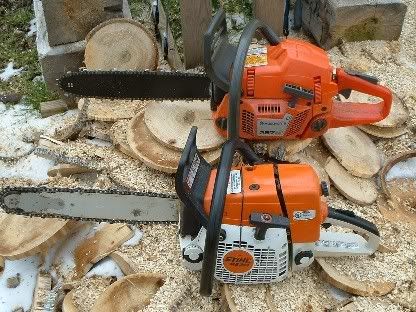You are using an out of date browser. It may not display this or other websites correctly.
You should upgrade or use an alternative browser.
You should upgrade or use an alternative browser.
I'm trying to decide what to do my my backup saw.
- Thread starter crazyal
- Start date
- Views: 5264
More options
Who Replied?
/ I'm trying to decide what to do my my backup saw.
#11
crazyal
Super Member
Back in the day (when I was much younger) I raced 2 stroke motorcycles. Hare scrambles, not motocross. Each winter I would put my CR250 in the basement and tare it apart. Over the years I've had several cylinders replated. I don't think you could port a dirt bike cylinder since they have mechanical valves to adjust the exhaust port. Depending on the design some would need the carbon removed often or they would gum up or build up and when the valve closed the carbon would rub on the piston. I've never had the need to port a 2-stroke cylinder (I have ported and polished intake manifolds on car engines) so I never had any experiences with longevity. I actually debated having my cylinder ported but the saw has lots of hours on it so I wasn't sure pushing it further was going to be a good idea. If I replace the crankshaft, main bearings, and seals I still might do it. But since it's going to be a limbing, small tree saw it really doesn't need more power. Still I would like to learn about porting.
dfkrug
Super Member
- Joined
- Feb 3, 2004
- Messages
- 7,680
- Location
- Santa Cruz Mtns, CA
- Tractor
- 05 Kioti CK30HST w/ Prairie Dog backhoe, XN08 mini-X
Back in the day (when I was much younger) I raced 2 stroke motorcycles. Hare scrambles, not motocross. Each winter I would put my CR250 in the basement and tare it apart. Over the years I've had several cylinders replated. I don't think you could port a dirt bike cylinder since they have mechanical valves to adjust the exhaust port. Depending on the design some would need the carbon removed often or they would gum up or build up and when the valve closed the carbon would rub on the piston. I've never had the need to port a 2-stroke cylinder (I have ported and polished intake manifolds on car engines) so I never had any experiences with longevity. I actually debated having my cylinder ported but the saw has lots of hours on it so I wasn't sure pushing it further was going to be a good idea. If I replace the crankshaft, main bearings, and seals I still might do it. But since it's going to be a limbing, small tree saw it really doesn't need more power. Still I would like to learn about porting.
I had a motocross bike 30+ years ago, too. Just for screwing around on. First year water-cooled 81 Yam YZ125. Long
gone.
Now, I have a more modern, but vintage mid-90s Suzy RM125 racing kart, and it has the exhaust power valve.
The racers tell me they go as rich as 33:1 on the premix, even when they use exotic full-synthetic oil. They
DO gum up the exhaust, but rebuild every 40hr or so. Not me: 50:1, but soon, full-synth oil.
Anyway on chainsaws, I often see the exhaust port not very well-matched to the gasket, and that's an
easy fix. Gaskets are not really necessary anyway. What folks need to know is that you have to
periodically clean the exh ports of carbon deposits, which get sucked into the cylinder and scratch it.
Tossing the spark-arrestor also helps breathing.
You are not doing any 2-stroke favors by running richer than 50:1 as it increases deposits. 50:1
oils (JASO-FD) work very well on older saws, too.
crazyal
Super Member
I had a neighbor that had a Mccolloch Eager Beaver chiansaw that he would run at 16:1. If it was a nice still day all you could see was exhaust smoke. He was always going through plugs and the muffler looked like the Exxon Valdez. But he swore that was better than running at the recommended 32:1. I usually run around 40:1 but I keep an eye on the plug and muffler. Oil is cheap so I don't mind burning a little extra. I think it's an old habit (kind of like my old neighbor) from the Lawnboy days. They were probably the best push mower ever made yet I lost count of how many were killed by running straight gas. I like to see the gas visibly different in color to know that it's not straight gas.
